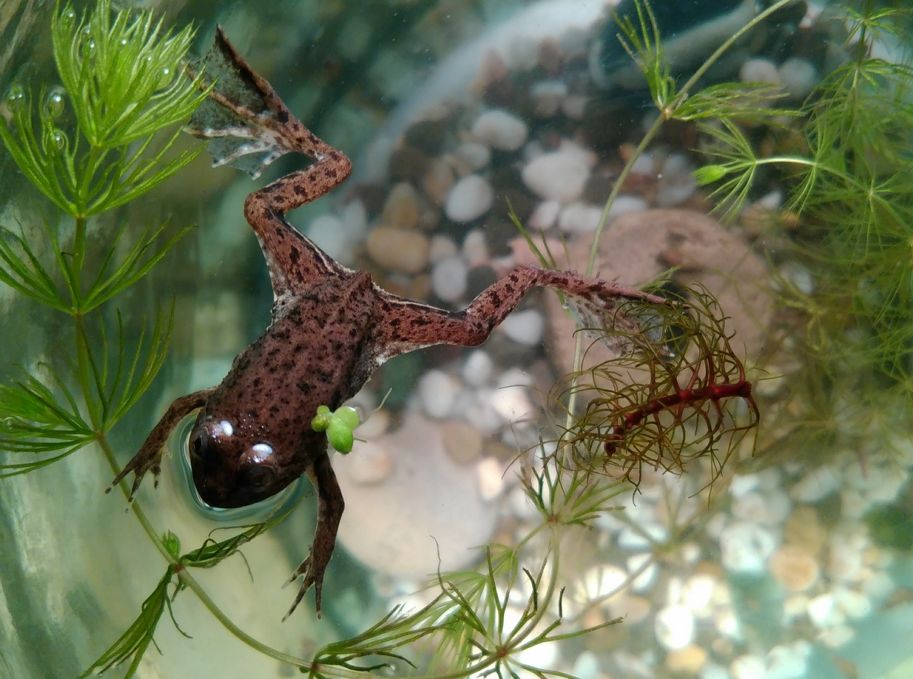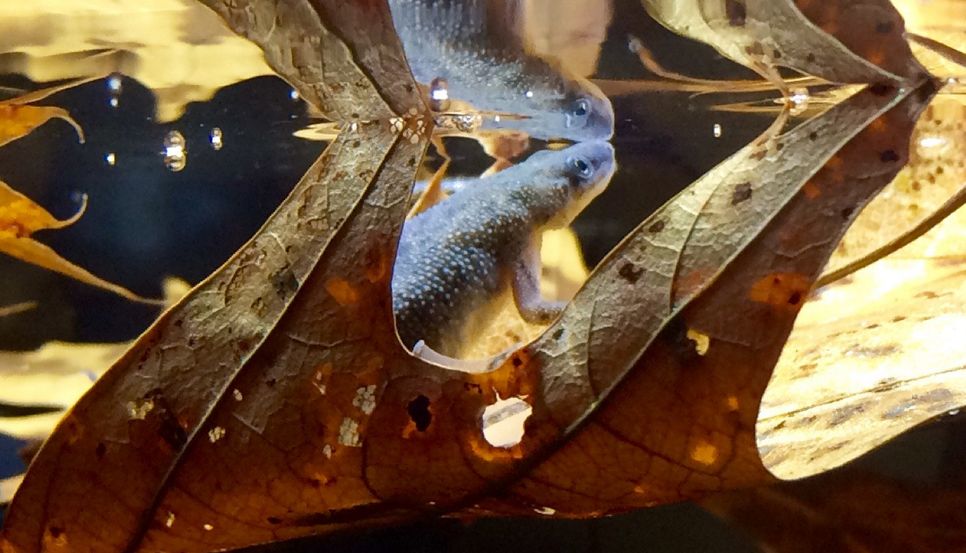The African dwarf frog is a small and peaceful amphibian increasingly popular in aquariums. As a true water frog, it can thrive entirely underwater without the need to venture onto dry land. There are four species within this family, all sharing similar behaviors and care requirements. This article will provide a general overview applicable to all African dwarf frogs.

Contents
Habitat in the wild
Birthplace of these small amphibian is in African equatorial forests – Nigeria, Zaire, Cameroon, Kongo. Usually the african dwarf frogs dwell in shadowed lowlands of slowly flowing rivers, bogs and puddles. These frogs live in water all the time and they don’t go out to dry land. However, they rise to water surface to breathe some fresh air.
They differ from other representatives of Pipidae family because they have webbed fore feed. Due to this fact the african dwarf frogs got its Latin name: the word Hymenochirus can be translated as ‘webbed feet’ or ‘the one with leathern feet’.
African dwarf frogs are commonly found in slow-moving freshwater environments, such as rivers and lakes, in their native regions of Africa. Unlike many frogs, they are fully aquatic and do not leave the water for breeding. These frogs can often be seen swimming gracefully and occasionally surfacing for air. Their buoyant bodies allow them to float effortlessly, making them agile swimmers.
Description
The African dwarf frog is a fascinating aquatic species known for its small size and graceful appearance. Adult African dwarf frogs typically reach a length of 3.5 to 4 cm (approximately 1.38 to 1.57 inches). These frogs become sexually mature around the age of 12 months, with a lifespan that can extend up to five years or sometimes even longer under optimal care.
Physical Characteristics
Physically, the African dwarf frog has a slender body and long, thin limbs, complemented by a pointed snout featuring nostrils at its tip. This petite amphibian usually exhibits a dark gray or brown coloration, adorned with scattered black spots across its body. The lighter-colored abdomen often has fewer spots, contributing to its delicate appearance. Their smooth skin allows them to blend into their environment, providing camouflage against predators.
| Scientific Name | Hymenochirus |
| Common Name | African dwarf frog |
| Tank size | 25 liters (5.5 gallons) and more |
| Temperament | Peaceful |
| Diet | Omnivorous |
| Temperature | 72°F- 78°F (22 to 26 °C) |
| pH | 6.0-7.8 |
| Size | up to 3.5-4 cm (1,38-1,57 inches) |
| Lifespan | up to 5 years |
Difficulties in keeping
This is a small, peaceful and undemanding species. Recently, it has become quite popular and this is almost the only kind that can be kept in a tank. Other frogs are larger and more aggressive; to keep them successfully they require a possibility of going out to dry land (for example, African clawed frog or xenopus).

Care and keeping in a tank
Water Parameters for African Dwarf Frogs
To successfully keep African dwarf frogs, it’s essential to maintain a tank with water that has medium hardness and a pH within the range of 6.5 to 7.8. Like all amphibians, these frogs are cold-blooded, meaning their metabolism is influenced by the external temperature.
In the wild, African dwarf frogs thrive in small puddles and bogs with easily warmed, sometimes unclean water. Therefore, it’s crucial to provide warm water in captivity, ideally not less than 20 °C (68 °F), with 24 °C (75 °F) being even more favorable. If kept in colder water, they become more susceptible to various diseases.
The optimal water temperature for these frogs is between 22 and 25 °C (71.6 to 77 °F), although they can tolerate greater fluctuations. The specific water parameters to monitor include: pH 6.5 to 7.8, general hardness (gH) 5 to 20, and carbonate hardness (kH) 4 to 15.
Due to their soft and spongy skin, African dwarf frogs are highly sensitive to chemicals, making it advisable to avoid handling them to prevent stress and injury.
Tank Decor and Environment
For one or two pairs of African dwarf frogs, a tank with a capacity of at least 25 liters (5.5 gallons) is recommended. The substrate can be gravel, but it should be rounded and large enough to prevent the frogs from accidentally ingesting it while eating. A sandy bottom or river stones with a diameter of 3-5 mm are also suitable options.
These frogs do not require any dry land and can live their entire lives underwater. However, they do need to rise to the water’s surface periodically to breathe, as they cannot stay out of water for longer than 10 to 15 minutes without risking dehydration and death.
It’s essential to ensure that the tank is securely closed, as African dwarf frogs can escape. The tank should provide free access to atmospheric air, facilitating their natural breathing habits.
Water Flow and Quality
Creating a slow water flow in the tank is advisable, but the filtration system should not be too powerful. To protect their delicate limbs, you can use foam or a net with small openings on the filter intake.
African dwarf frogs are not particularly demanding regarding water quality, and frequent water changes are generally unnecessary and may even be undesirable. They thrive in still water but benefit from some aeration. It’s beneficial to have at least one corner of the tank with calm, lentic water.
Behavior and Habitat Preferences
Young African dwarf frogs are active swimmers but also enjoy resting on floating plants or large leaves. They often hide under broad-leaved plants, driftwood, or stones, which provide them with a sense of security.
For tank plants, it’s recommended to include large-leaved varieties with strong roots, anchoring them with stones to prevent digging.
African dwarf frogs obtain oxygen not only through their lungs but also partially through their skin. This dermal respiration accounts for about one-third of their breathing volume when at rest and approximately one-tenth during activity.
Shedding and Care
Every few weeks, as they grow, African dwarf frogs shed their skin. This process involves intense rotary motions that may appear as tossing and turning. They often eat their shed skin, which is a natural behavior. If they do not consume it, it’s best to remove the shed skin from the tank the following day to maintain cleanliness.

Feeding
African dwarf frogs thrive on a varied diet that includes various live foods commonly used for fish, such as daphnia and tubifex. Bloodworms can be offered once or twice a week, but it’s essential to note that they have low protein content and lack many vital amino acids.
Feeding Behavior
As amphibians, African dwarf frogs are particularly responsive to movement. They may be less enthusiastic about stationary food, although some aquarists successfully feed them frozen or artificial options. These frogs are natural predators at all life stages, which influences their hunting and feeding habits.
Unlike many other animals, African dwarf frogs do not chew their food; instead, they gulp it and gradually swallow it. Lacking both teeth and a tongue, they require food that is small enough to consume whole or can be ground down through their unique feeding movements.
Feeding Frequency
It’s recommended to feed African dwarf frogs every 2 to 3 days. If they are housed in a community tank with faster fish, it’s vital to monitor their feeding to ensure they are getting enough to eat. Given that fish are typically quicker, frogs may struggle to compete during feeding times.
Vision and Hunting Techniques
The positioning of a frog’s eyes—far apart on either side of its head—provides a wide field of vision directed forward. This unique placement makes it challenging for them to see objects close to them or directly in front. As a result, African dwarf frogs rely heavily on their sense of smell and touch to locate food.
You may often observe them groping around the tank bottom, searching for missed morsels. This can take several minutes, as they use their sensitive skin and tactile senses to find food.
Tank mates
African dwarf frog get on well with fishes of similar size. Considering their slow temper and small size they may eat small fishes and juveniles. This is an omnivorous predator, though it is small.
African dwarf frogs are compatible with Amano shrimp, red cherry, glass shrimp. However, they aren’t compatible with large crawfish, cichlids (Texas cichlid, convict cichlid, flowerhorn). It’s better to keep these frogs together with peaceful fishes such as betta fish, swordtail, platy.
Breeding
Breeding African dwarf frogs is quite similar to the breeding process of many aquarium fish. To stimulate breeding, raise the water temperature to 26-28 °C (79-82 °F) and increase the lighting levels, as longer photoperiods can encourage spawning. Additionally, performing partial water changes can help mimic natural conditions that trigger breeding behaviors.
Spawning Behavior
The water level in the spawning tank should be at least 20 cm deep to accommodate the mating behaviors of the frogs. During courtship, the male and female will swim in vertical circles, a behavior characteristic of many amphibian species that lack a tongue.
Egg Laying
The eggs laid by African dwarf frogs are jelly-like and will float on the surface of the water. A female typically lays between 50 and 200 eggs, although numbers can go up to 500 in some cases. Once spawning is complete, it’s advisable to remove the breeding pair from the spawning tank to prevent them from eating their eggs.
Hatching and Larval Care
The eggs will hatch within 1-2 days, producing black larvae approximately 3 mm long. Initially, these larvae will attach to the leaves of tank plants or hover near the water’s surface.
As soon as the larvae begin to swim freely, you should start feeding them. Their dietary needs are similar to those of juvenile fish; begin with infusoria, which are tiny microorganisms that provide essential nutrients. Over the next month, the larvae will undergo metamorphosis, gradually developing into adult frogs.